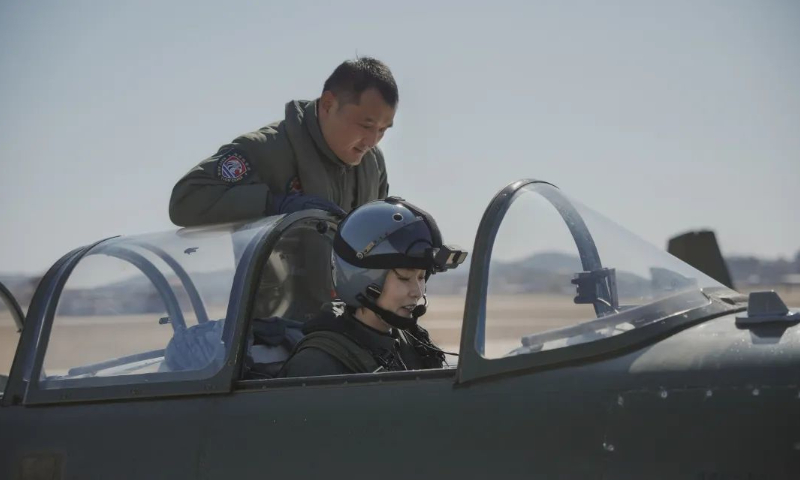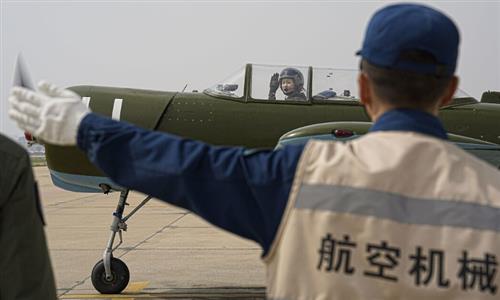
A member of the first group of female carrier-based aircraft pilots in China prepares for a maiden flight. A flight instructor guides the trainee pilot. Photo: Chen Chao
After the first group of female pilot trainees from the carrier-based aircraft of the Chinese People's Liberation Army (PLA) Navy completed their inaugural solo flights in April, one of the female pilots told the Global Times that becoming a female cadet pilot is her quest. "I want to get on the best ship and fly the best aircraft," she said.
The PLA Navy started to recruit female cadet pilots to fly carrier-based aircraft for the first time in its 2023 recruiting program, according to the Xinhua News Agency. The recruiting program has been expanded to include science and engineering graduates from universities as well as college students who are doing military service in the Chinese navy. The first group of female cadet pilots began their studies at the Naval Aviation University following selection procedures.
They have completed a number of basic courses including aviation theory and parachute rescue, and have achieved excellent results in various assessments. After transferring to a training regiment, they completed theoretical study, cockpit practice and air practice, as well as independent ground taxiing, establishment of routes, and other basic flight ability training in less than four months.
After they completed their inaugural solo flights on April 25, a stage marking that they have the ability to independently fly an aircraft, they will also have training on instrumentation, formation, navigation, night navigation and other courses.
Becoming a pilot requires a high level of overall quality, and they need to master basic knowledge and skills in meteorology, including wind direction and wind speed calculations.
"Wind has a great impact on aircraft handling, and when I first learned to fly, it was a challenge for me to handle the aircraft well under different weather conditions," Guan Meifang, a female cadet pilot told the Global Times. "When piloting a fighter aircraft, you need to combine real-time wind direction to determine the direction of takeoff and landing, and correct the maneuver deviation in time."
The Global Times also noticed a model of the primary trainer they are flying on the desk, which was also the only ornament in the dormitory of the female cadet pilots. The cadets will use the aircraft model for ground exercises, recall the whole set of actions carried out in the cabin, review the deficiencies in the previous training, and strive to improve the formation of muscle memory in order to better solve the problems encountered.
Guan said that she wants to become a pilot of carrier-based aircraft, and flying skill is the key requirement.
The state of "human-machine unity" is the next goal that Guan wants to pursue. She said she hopes that in the near future she will be able not only to manipulate the aircraft, but also to sense the aircraft, and have the ability to anticipate subtle changes.
Flight instructor Yang Donglin spoke highly of this group of female pilot trainees, saying they have "solid theoretical foundations, and strong learning ability," and they also "work hard."
Yang noted the importance of maneuvering precision, as the ship can be easily swayed by the influence of wind and waves, coupled with effects of complex sea conditions. It means the requirements for a pilot's precise control are very high.

